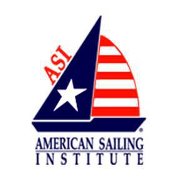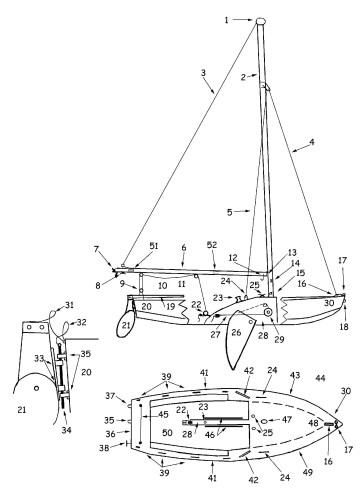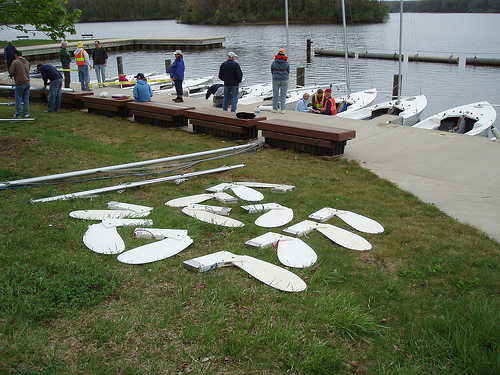Here’s info on basic sailboat safety.
Things you can do before sailing class
One is get to know the “Language” of the sailboat and all its parts. Yes, it’s a bit like a foreign language but you’ll be surprised how quickly you will get it! Sailing is much smoother and safer when everyone knows the same names for the parts of the boat. ‘Ease the jib sheet!’ rather than ‘pull the thing-a-majiggy!’
Learn Navigation Rules
There are two terms that help explain these rules to get you started.
Stand-on vessel: The vessel that should maintain its course and speed
Give-way vessel: The vessel that must take early and substantial action to avoid collision by stopping, slowing down, or changing course.
Learn and Practice your Knots
Check out this nice animated knots video. .Knots can be practiced before you come to class. In fact you can bring a short piece of line to class.
- Bowline
- Sheet Bend (single)
- Square (Reef)
- Figure 8 (Stopper )
- Cleat Hitch
- Half Hitch (Clove)
- Chain stitch (tie main onto the boom)
- 3 wasy to coil a line (pg 14 of handout, found under”Students Home Port” page(use password))
- Clove Hitch
Safely entering and moving around the boat at dock
Once in class on the water take your time checking out the boat and do a “check list”, your boat Mentor can help you develop one, just ask. Then get to know the balance of the boat and be comfortable with that as you move around the boat slowly at the slip.
Check out this Boat Safety e-book on line.
Also check out the Power Squadron classes here, you will need this class for our upper level sail passes.
To get into sailing, you have to understand the words that are used to talk about the sailboat and the skills used to sail. Start here with a review of basic sailing terms. Don’t worry about memorizing everything – many of these terms and concepts will become clearer as you read on about how to do it.
Before you go the boat, it’s really helpful also to know the words used for different parts of the boat. Even if you have an instructor, he or she won’t say “Grab that rope over there and pull it” but instead will say “Haul in the jibsheet!” Here’s a review of the basic boat terms you’ll need to know.
Now you’re ready to learn more about what all those parts of the boat are used for. Here you can start an online learn-to-sail course by learning more about the parts of the boat along with a lot of photos so you’ll see what to do.
Ready to go sailing now? Hold it a minute – you have to rig the boat first by putting on sails and making other preparations. Here again are a lot of photos of what to do on a typical small sailboat used by beginners.
OK, now you have the boat ready – so what do you do now to make it go? How do you manage the sails to go in the direction you want, and all that? Learn basic sailing techniques here.
Sailing in a set direction is reasonably easy – but eventually you’ll have to change direction, and that often involves tacking and gybing. Take a moment to learn what’s involved in these critical maneuvers.
Now you’ve got the basics down – great! But did anyone ever tell you that small sailboats often tip over if the wind is gusting? Better be prepared and know how to recover from a capsize!
Now you’re out there sailing and you’ve got the boat under control. Want to go faster? Learn how to dock or anchor the boat or use some of the equipment you’ve ignored so far? Take a look at some of these additional sailing skills.

All set to go and get some practice – but it’s cold or raining? For thousands of years, sailors have used such times doing things like tying knots. Maybe it sounds dull at first, but knots are really important on a sailboat – you will need to learn at least some basic sailing knots to sail at all.
At this point, plus some practice on the water, you’re good to go – except for one more thing. It’s good to remember that water is a dangerous place and learn the basics about sailing safety so that you don’t become one of those terrible statistics. Staying safe just makes it a lot easier to keep having fun out there.
That’s it! Now get out there and use all your new knowledge and have the time of your life!
Be safe with PFD’s
Life jackets / PFD’s (Type II) are provided by ASI. You may wear your own
PFD if it is a Coast Guard approved Type I, II, III or V (note a Type V must
be worn at all times to be counted as a regulation PFD).
Personal Flotation Devices (PFD‟s)
The US Coast Guard requires a minimum of one wearable USCG approved PFD‟s for every person on board and one Type IV throwable device
(cushion, ring, horseshoe-buoy) per boat (exceeding 16„) All persons less than 6 years of age shall wear a Type I or Type II PFD at all times.
ASI requires that all persons on board wear a Type I, II, III, or V PFD during every on-the-water Instruction Class.
Type V (Hybrid Inflatable Device) PFD‟s must be worn at all times to be counted as a regulation PFD.
Let’s all enjoy sailing at our three docking locations in Southeast Michigan, Kent Lake at Kensington Metropark, Stony Creek at Stony Creek Metropark and Jefferson Beach Marina in St. Clair Shores, Michigan.



